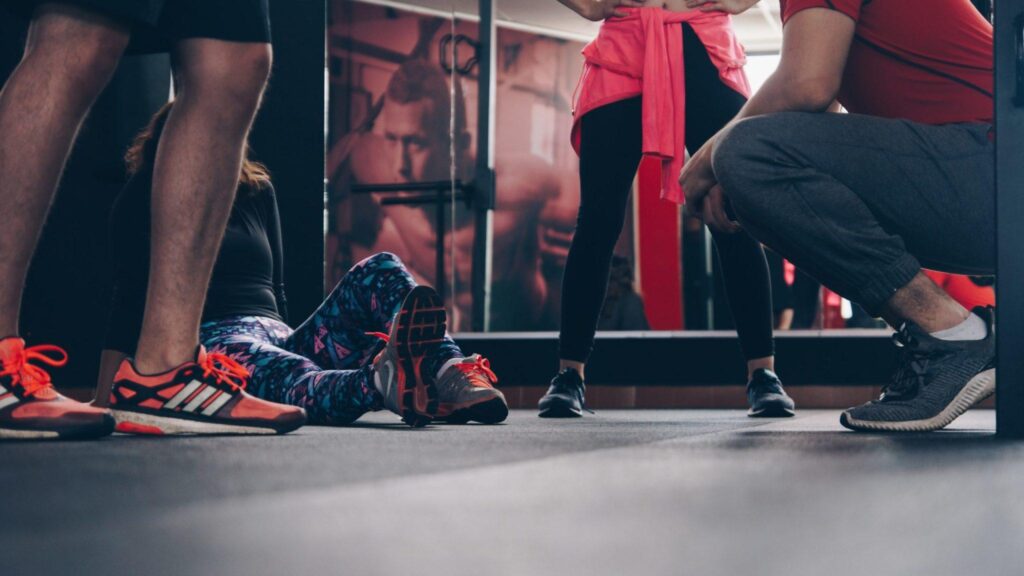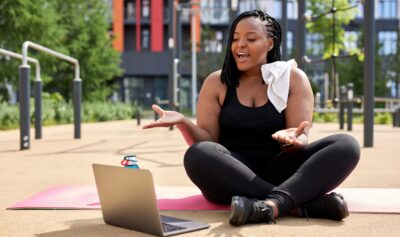At Glofox we believe that having a strong brand is the key to differentiating yourself from your competition and building a loyal following from your members. Big international franchises like F45, Orangetheory and Soulcycle are examples of this. They have unique slogans, wording, tone, color schemes and culture that resonates strongly with your members.
In our popular blog on branding a fitness business, we talk about The Ultimate 5 Step Fitness Studio Branding Framework. This framework gives you a process that can help you develop your own brand. One step in the process is “Define What Make You Different” which is all to do with brand identity. What this means is that you need to develop a unique set of values that makes your brand different from everyone else.
So in this article, we will take a look at what branding is, why it matters and how you can develop a brand identity for yourself.
Skip ahead to:
- What Is Branding and Why Does It Matter?
- Examples of Great Fitness Branding to Inspire Your Own Brand
- 10 Steps to Developing Your Brand Identity
What Is Branding and Why Does It Matter?
What Is Branding?
Although “branding” comes from the ancient practice of branding cattle with your logo to signify ownership, the term has taken on a whole new meaning in modern marketing.
Your brand is not just your logo design, color scheme, visual elements, venue, web design, product, values, or any other component of your business. It’s all of those things — and more.
In short, your brand is the sum total of all your efforts as a business.
When done correctly, your brand will be the sum that is greater than all the individual parts.
Why Does Branding Matter?
That’s all well and good, you might think, but what’s wrong with just setting up a decent fitness studio and running it well? Why go the extra mile to create a brand?
Because branding will pay off — both in the short run and over time.
Yes, it may seem like a lot of extra work of which you may don’t see the immediate benefit. But since you’ll have to do most of the things it takes to create a brand anyway, all you need to do is put all the pieces together.
Here are some of the main benefits you’ll enjoy when you have a solid brand in place:
- Direction – Your brand tells you what to do next, how to market yourself, and how to stay true to your core values.
- Competition – A good brand will set you apart from your competition so it’s easy to tell you apart in a crowded market like the fitness world.
- Recognition – People will instantly recognize your brand, even if they don’t immediately know it’s your business, based on the feelings you instill in them.
- Consistency – Branding brings order to chaos and enables you to stay consistent across platforms, markets, and even time.
- Trust – That brand consistency will build trust with your target market so they know what to expect every time they interact with your business.
- Loyalty – Finally, and most importantly, the trust you build with customers will turn into powerful brand loyalty, which is incredibly valuable.
As you can see, a brand is real estate. Need some actual proof? Let’s look at what other fitness studios have done in terms of branding.
Examples of Great Fitness Branding to Inspire Your Own Brand
You know what branding is and why it’s important. Now it’s time to look at some real-life examples of how it works in action.
We’ve rounded up some of the most well-known fitness brands that have mastered the art of branding both online and offline.
See if you can spot the similarities and identify the red thread that runs through their branding strategies.
1. Equinox
Equinox is one of the most well-known gym chains in the US, and there’s a good reason for that. Their branding is amazing, and the best part is that they built it up from almost nothing within one year. From 2012 to 2013, they more than doubled their online following through rebranding.
How did they do that? First of all, they came up with a great slogan: “It’s not fitness … it’s life.” But they also began to publish lifestyle content to go with that slogan and ran engaging competitions on social media.
Finally, they also tapped into the concept of community by donating to cancer research.
2. Crunch Gym
Crunch Gym is another fitness franchise that has had great success with their online branding. They now count over 250 branches across the world — and they’re still counting.
Crunch Gym peppers their social media feeds with short videos that give their target audience quick tips on how to expand their fitness routine. They’ve also capitalized on Foursquare as a marketing tool, and regularly offer their members special perks. These include free bottles of water and guest passes.
Finally, they’ve also run charity fundraising campaigns similar to Equinox above.
3. Nike
Nike is one of those brands that almost need no introduction. But it’s exactly for that reason we need to give them a mention here. When you see the “Swoosh” logo, you immediately know what it’s all about: “Just Do It.”
They’re not afraid to partner with well-known celebrities who then wear their clothes in marketing campaigns. But they also offer insightful background stories from athletes to inspire their audience.
The best part? Most of the time, they only have to make a minimal reference to their own brand… you already know it’s Nike.
4. Under Armour
Under Armour is so much more than just a sportswear brand. Sure, their main bread and butter is state-of-the-art fitness clothing that will keep you warm or cool (depending on the sport) all the while you stay comfortable. But their brand focus is on “fan activation.”
They want you to actually go out and use their products to get in shape. Perhaps the key to their successful brand is that they activate their fans in more than one way. Their Ultimate Intern program invited fans to pitch themselves to the brand in order to win an internship as their next social media specialist.
5. Spartan
Spartan is built around a massive obstacle course. The biggest one in the world, in fact. But this great brand offers more than impressive structures.
They sell wellness programs, nutrition products, and athletic wear. When it comes to the races on their obstacle course, they’ve heavily utilized live streaming.
The Top 10 Barriers
Slowing Your Fitness
Business Growth
Discover more You can watch their brand live and in action from the comfort of your own mobile device. Alongside their many inspirational quotes, that will hopefully inspire you to take part.
10 Steps to Developing Your Brand Identity
Okay, so we’ve covered what branding is and how some of the biggest fitness companies have created their massive brands. Now the time has come to develop your own brand strategy.
1. Think About Yourself and Your Fitness Studio
Your brand personality starts with you. Hopefully, you’ve chosen to be in the fitness industry because you like sports and exercise.
So formulate what you love, why you love it, and what you’d like to contribute. That will form the basis of your fitness studio brand.
As Simon Sinek says in his world-famous book and speech, “Start With Why.”
2. Research Competition Fitness Studios and Brands
Once you know why you’re in the game and what you want to change, it’s time to look at the competition.
What are they doing right, and what are they doing wrong? How can you set yourself apart from them and their brand? Why should people choose your fitness studio over theirs?
Conduct some in-depth market research.
3. Understand Your Ideal Customer and Their Desires
Now that you’ve looked at the competition, maybe you’ve discovered that you don’t even fight for the same audience. Maybe the people you want to attract are completely different.
But who are they, exactly? And, more importantly, what do they want? When they look at the market for fitness studios, what’s missing from the picture?
4. Write A Mission Statement and Find Your Voice
Now that you know who you want to target and how to reach them, it’s time to formulate a mission statement for your fitness brand.
What are your core values and how will they be reflected in the way you conduct your business? Do you want to push your clients to the max and enhance their athletic performance? Or do you want to create a sense of community and team spirit?
5. Choose An Appropriate Name (and Visual Identity)
Have you written a mission statement? Developed a brand voice? Good. Now it’s time to come up with a name that reflects that and some visuals to go with it.
Think about the examples we covered earlier. Nike is a reference to the Greek goddess of victory. Spartan is named after the fierce warriors of Sparta.
Choose a name and visuals that embody your brand values.
6. Maintain Consistent Brand Guidelines
Consistency is key to many things in life, especially exercise. It’s better to do ten pushups every day of the week than to do thirty pushups one day and then have no energy to do them the next.
Same with brand consistency.
It’s better to have simple but consistent branding than to focus all your efforts on one area and neglect the rest.
7. Create Helpful Content and Share Inspirational Stories
You probably noticed a pattern with the examples we covered earlier. They all shared helpful content with their audience to improve their fitness routine. They also shared inspirational stories from world-class athletes or from their own fanbase.
The motivational and aspirational aspects of your brand will help create a sense of community and commitment.
8. Run Marketing Campaigns That Engage your Audience
It’s not enough to tell people to “get out there and get active.” You need to engage them wherever they are, and that includes online platforms such as social media.
As you saw, the examples we used all ran online competitions and participated in charity fundraisers. Identify some ways you can engage your audience both online and offline.
9. Analyze Your Marketing Data and Learn From It
Once you’ve engaged your audience, you’ll be left with some data. That could be in the form of email campaigns you’ve run or social media content you’ve posted.
It’s important that you take your time to analyze it and learn from it. What went right? What went wrong? How can you improve your next interaction with new customers?
10. Ask Your Customers for Feedback and Implement It
Data can give you a lot of insights but at the end of the day, it’s just a bunch of numbers. And numbers only tell part of the story. The rest of the story comes in the form of real spoken or written feedback from your audience.
What do they think about your brand? What does it make them feel? What would make them more invested in your fitness studio? How can you take it to the next level?
In Summary
So now you know what branding is, why it’s so important, how other companies have done it, and how you can develop your brand identity.
Here are some key takeaways:
- Your brand is the sum total of all your business efforts.
- Base your brand on your own personal values as a business owner.
- Watch what the greats (and your competitors) are doing.
- Create an experience rather than sell a product to potential customers.














